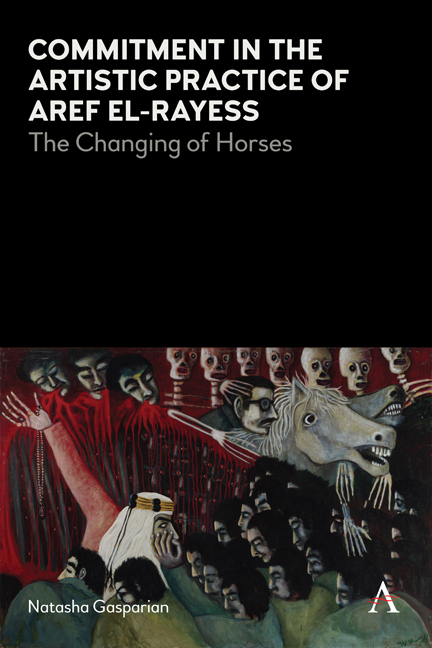Summary
Blood and Freedom ushered in a new, politically committed, chapter in Aref El-Rayess's artistic practice. Aesthetically, his political commitments were translated into varying, and at times incongruent, forms. He remained devoted to the medium of painting, in spite of his critical attitude toward the academicism that permeated even the most modernist of practices. His paintings continued to lay claim on the social world, but they grew stranger, uncannier—in other words, more surrealist—over time. For instance, the masks that had first appeared in The Changing of Horses returned in a series of paintings, entitled Ruʾus wa Aqdam (Heads and Feet) (Figure C.1), in the solo exhibition, al-Hub, al-Mawt, al-Thawra (Love, Death, Revolution) at Dar El-Fan in 1970. There the masks took on a life of their own—entire paintings were dedicated to nothing other than variations on these motifs. Similarly, the image of the blinded masses in The Changing of Horses reappeared in the 23 small-scale paintings in the 1974 solo exhibition, Fusul min Waqiʿ ʿAlam al-Thalith (Chapters from a Third-World Reality).
Apart from his realist method—which restaged, with every work, the contradiction between the drive for demystification and the modernist impulse for defamiliarization—El-Rayess also curiously retreated to traditional genres like the still life in between bursts of militant productivity. Critics, even those who knew him intimately, often did not know what to make of such lapses in consistency. A statement in the catalog accompanying El-Rayess's 1974 show, and which was issued under the institution's name, hints at El-Rayess's selfcontradictory practice:
[Aref El-] Rayess's passage from one style to another is as violent as his changes in humor, which represent the entire range of human reactions, from blind anger to exquisite reveries of the passage through love, politics, ideas and principles. Since June 67, the political event has not ceased to be his principal preoccupation. His exaltations at nature and his vacations among the flowers of his garden are followed by harsh and surprising awakenings. They constitute a commentary on the event, as seen through an optic that is sensitive to an exasperating degree, and which is faithful to progressive thought.
- Type
- Chapter
- Information
- Commitment in the Artistic Practice of Aref El-RayessThe Changing of Horses, pp. 49 - 52Publisher: Anthem PressPrint publication year: 2020



